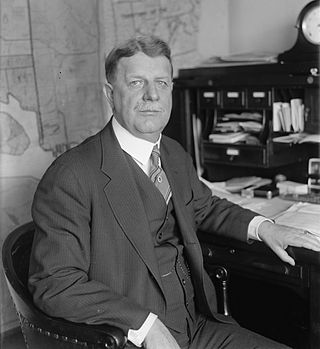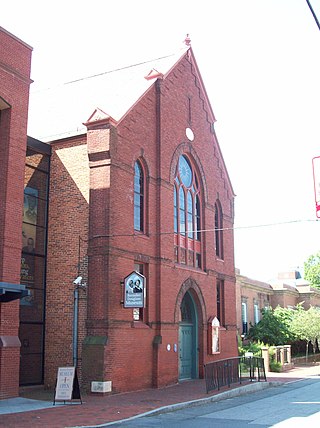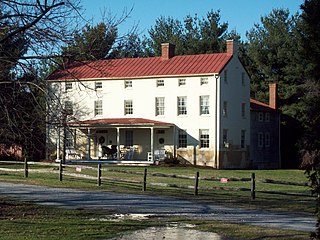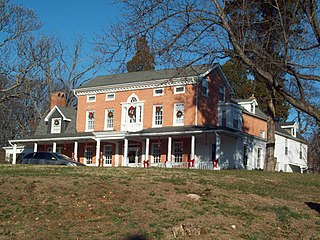
Anne Arundel County, also notated as AA or A.A. County, is located in the U.S. state of Maryland. As of the 2020 United States census, its population was 588,261, an increase of just under 10% since 2010. Its county seat is Annapolis, which is also the capital of the state. The county is named for Anne Arundell, Lady Baltimore, a member of the ancient family of Arundells in Cornwall, England, and the wife of Cecilius Calvert, 2nd Baron Baltimore (1605–1675), founder and first lord proprietor of the colony Province of Maryland.

Crofton is a census-designated place and planned community in Anne Arundel County, Maryland, United States, located 9.8 miles (15.8 km) west of the state capital Annapolis, 24 miles (39 km) south of Baltimore, and 24 miles (39 km) east-northeast of Washington, D.C. The community was established in 1964 and as of the 2020 census, it had a population of 29,136.

Linthicum is a census-designated place (CDP) and unincorporated community in Anne Arundel County, Maryland, United States. The population was 10,324 at the 2010 census. It is located directly north of Baltimore–Washington International Thurgood Marshall Airport (BWI).

Odenton is a census-designated place (CDP) in Anne Arundel County, Maryland, United States, located approximately 10–20 minutes from the state capital, Annapolis. The population was 37,132 at the 2010 census, up from 20,534 at the 2000 census. The town's population growth rate of 80.8% between 2000 and 2010 was the greatest of any town in western Anne Arundel County. Odenton is located west of Annapolis, south of Baltimore, and northeast of Washington.

Elkridge is an unincorporated community and census-designated place (CDP) in Howard County, Maryland, United States. The population was 15,593 at the 2010 census. Founded early in the 18th century, Elkridge is adjacent to two other counties, Anne Arundel and Baltimore.

John Charles Linthicum was a U.S. Congressman from the 4th Congressional district of Maryland, serving from 1911 to 1932.
Woodwardville is an unincorporated community situated in western Anne Arundel County, Maryland, United States, containing 27 structures, 16 of which are historic and included in the Woodwardville Historic District, listed on the National Register of Historic Places in 2003. Most of the structures are located adjacent to Patuxent Road, which runs through the center of the community. On the north end of the district, a small street, 5th Avenue, runs west from Patuxent Road underneath the train tracks. Prior to the establishment of what would be later known as Fort George G. Meade in 1917, the road once continued on to Laurel. Three of the seven buildings along 5th Avenue are historic. Woodwardville's building stock consists principally of late-19th and early-20th century domestic architecture. Good examples of the Bungalow, Foursquare, Tudor Revival, and Queen Anne styles are present, as well as older traditional vernacular classifications such as the I-house. These older forms are supplemented by a handful of post-World War II era structures. Woodwardville also features several public or commercial buildings including a church, a former schoolhouse, the ruins of a store and storage or service buildings associated with the railroad. Many of Woodwardville's older buildings fell into decline following World War II, but in recent years, due to its close proximity to commuter rail service, Woodwardville has evolved into a bedroom community for persons working in Washington and Baltimore. Investment by new residents resulted in the restoration and renovation of many buildings which had formerly been in deteriorating condition. Despite the intense development a mile away in Piney Orchard, this quaint community retains its ability to communicate its historic qualities and distinct sense of place.

The Banneker-Douglass Museum, formerly known as Mt. Moriah African Methodist Episcopal Church, is a historic church at Annapolis, Anne Arundel County, Maryland. It was constructed in 1875 and remodeled in 1896. It is a 2+1⁄2-story, gable-front brick church executed in the Gothic Revival style. It served as the meeting hall for the First African Methodist Episcopal Church, originally formed in the 1790s, for nearly 100 years. It was leased to the Maryland Commission on African-American History and Culture, becoming the state's official museum for African-American history and culture. In 1984, a 2+1⁄2-story addition was added when the building opened as the Banneker-Douglass Museum.

The Savage Mill Historic District is a national historic district located at Savage, Howard County, Maryland. The district comprises the industrial complex of Savage Mill and the village of workers' housing to the north of the complex.

The Benson–Hammond House is a historic house located on Poplar Avenue in Linthicum Heights, Anne Arundel County, Maryland.

Sunnyfields is a historic home at Linthicum Heights, Anne Arundel County, Maryland, United States. It is partially brick, two and a half stories tall and three bays wide, and was built in 1810. The east portion is of frame construction, six bays long, and two stories high and dates from about 1785. It has characteristics from several periods of Maryland architecture: pre-Federal vernacular, high style Federal, and early-20th century mass-produced Classical Revival.

Turkey Hill is a historic home at Linthicum Heights, Anne Arundel County, Maryland, United States. It was built about 1822 by William Linthicum. Originally the house consisted of a 1+1⁄2-story frame section and a three-story field stone section linked together by an open porch. As the family increased in size, Linthicum added another story to the frame portion, making it two and a half stories high. Also on the property is a birdhouse, modeled after Camden Station in Baltimore City; a late-19th-century carriage house; a late-19th-century meathouse; and an early-20th-century garage also stand on the property.

Twin Oaks is a historic home at Linthicum Heights, Anne Arundel County, Maryland, United States. The house is a 2+1⁄2-story brick Greek Revival–influenced dwelling constructed in 1857, with additions and Neo-Classical embellishments made in the late 19th and early 20th centuries. The final composition is an eclectic, Georgian Revival–influenced dwelling. Twin Oaks was the home of U.S. Congressman John Charles Linthicum, who is noted for sponsoring the legislation which established The Star-Spangled Banner as the United States National Anthem. He entertained many dignitaries at Twin Oaks, including William Jennings Bryan and General Douglas MacArthur. Also on the property are a Victorian birdhouse, an aviary, a columned grape arbor, two freestanding concrete-cast columns, and a few pieces of statuary.

Linthicum Walks is a historic home and farm complex at Crofton, Anne Arundel County, Maryland, USA. It consists of a 19th-century frame dwelling, a mid-19th century meathouse, a frame pre-1815 tobacco barn and a family cemetery dating to the mid 19th century.

Anne Arundel County Free School is a historic school building, located in Davidsonville, Anne Arundel County, Maryland. The first Free School of Anne Arundel County was established by an Act of the General Assembly of colonial Maryland in 1723. It was built somewhere between its contractual date of 1724 and 1746 when it was under full operation with John Wilmot as schoolmaster. The existing abandoned building is 49' x 18', and consists of six rooms on two floors. It was built "as near the center of the county as may be, and as may be the most convenient for the boarding of children." The county then included what is now Howard County. It remained in operation until 1912 when the movement toward consolidation forced the closure of many early school buildings. It is the only surviving schoolhouse erected in Maryland in response to the Maryland Free School Act of 1723.

Davidsonville Historic District is a national historic district at Davidsonville, Anne Arundel County, Maryland. It is located around a rural crossroads at the intersection of Central Avenue and Davidsonville Road. The district consists of fifteen properties: three churches, one commercial building, and eleven houses. They represent the period from the village's initial settlement in about 1835 through the early 20th century.

Owensville Historic District is a national historic district at Owensville, Anne Arundel County, Maryland. It is located around a small crossroads community located at the intersection of Owensville Road and Owensville-Sudley Road. It consists of a concentration of historic buildings leading up to and clustered around the intersecting roads. It consists of 27 buildings, including two church complexes, 16 dwellings with their associated domestic outbuildings, and several agricultural buildings, including tobacco barns. Included in the district is the separately listed Christ Church. Much of the historic building stock dates between 1825 and 1875.

Woodwardville Historic District is a national historic district at Woodwardville, Anne Arundel County, Maryland. The district consists of 16 historic structures, most of which are located adjacent to Patuxent Road, which runs through the center of the village of Woodwardville. The district contains good examples of late-19th and early-20th century domestic architecture, including Bungalow, Foursquare, Tudor Revival, and Queen Anne styles. The village's development was directly related to the construction of the Baltimore & Potomac Railroad, initiated in 1867 and completed in 1872.

The Washington Street Historic District is a national historic district named after George Washington in Cumberland, Allegany County, Maryland. It is an approximately 35-acre (140,000 m2) residential area to the west of downtown Cumberland and consists primarily of six blocks of Washington Street. It contains large-scale 19th- and 20th-century houses representing most of the major architectural styles, including examples of Greek Revival, Italianate, Gothic, Queen Anne, Romanesque, Colonial Revival, and bungalow. Also included in the district are the 1890s Romanesque courthouse, the 1850s Greek Revival academy building, and the Algonquin Hotel. It was listed on the National Register of Historic Places in 1973.
Quarter Place is a historic home located at Lothian in Anne Arundel County, Maryland, United States. It was built in 1860 and is a 2+1⁄2-story Gothic Revival–style frame dwelling. It consists of a main block with a 2-story rear wing. The main block is three bays wide with a central entrance and features a central cross-gable roof.























